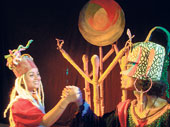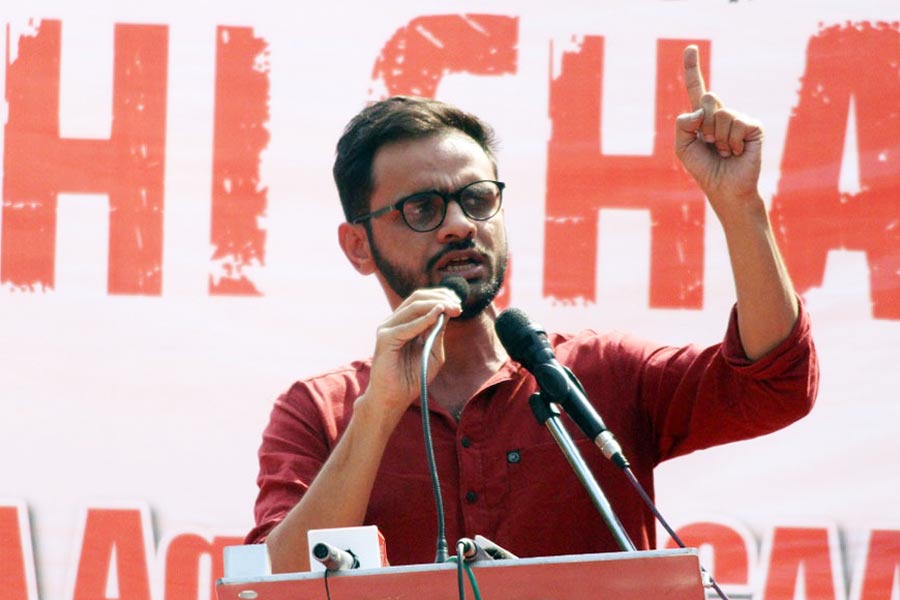 |
| Seagull performs Hattamalar Sipare in Assamese at Natya Shodh and (right) Badal Sircar |
 |
When on Day One of the Badal Utsav (July 15-19), Devendra Raj Ankur of NSD declared that proscenium plays were Sircar’s forte and that is what Sircar would be remembered by, one realised that this dismissal of a large section of Sircar’s oeuvre came from ignorance. To the majority of readers and theatre practitioners outside Bengal, who have no access to the monthly performances by Sircar’s troupe Satabdi at Nandan and Loreto Day School, Sircar is simply the writer of Ebong Indrajit, Ballabpurer Roopkatha, Pagla Ghoda and Baki Itihaas, which can be played on the conventional auditoriums.
Most of Sircar’s non-proscenium plays remain scattered in obscure journals. If some like Bhoma, Michhil, Gondi and Hattamalar Opare have been translated and performed in Hindi, Marathi and English, a larger number of plays such as Suitcase, Padma Nadir Majhhi, Memorandum Orey Bihongo and Parashuram remain unpublished. “What can I do if someone doesn’t like my later plays? Proscenium theatre is something I left long ago, my theatre is different now, it is what I believe in,” Sircar said later.
So why the scanty turnout on most days of the Utsav?
Was it because invitations went to a chosen few and there was little publicity? Or because the venue, Natya Shodh in EE Block, Salt Lake, was too off-centre a place? Yama Shroff of the Natya Shodh management, however, refuted this. “It was most convenient for us to do it in our own place. We not only have the required facilities, our timings could be flexible. We had quite a nice turnout with many people from Salt Lake dropping in. We always wanted this kind of local involvement.”
Or do traces of the scorn and incredulity that had greeted Sircar’s pioneering zeal in the 1970s linger still? By performing in the angan mancha (any open space shared uniformly by audience and actor, unlike proscenium theatre, where actors create an illusion on a stage guarded by curtains and the audience is at a distance), Sircar was trying to establish the Third theatre as something different from indigenous folk theatre forms and the professional Bengali theatre with its conventional production paraphernalia.
“Many in the group theatre fraternity found it hard to acknowledge that here was a theatre more pro-people and independent of sponsor and government support than theirs. So they tried their best to humiliate and ignore him,” explains theatre and film critic Shamik Bandhyopadhyay.
But Sircar’s proscenium plays were performed to full houses by many groups like Bohurupee. “His brand of humour was unique. Since he often drew on contemporary western literature and films his plays were able to soar beyond the stale and mundane themes which then clogged Bangla theatre. Both his proscenium and non-proscenium plays are equally important but I think there is scope for reinterpretation,” said dramatist and director Manoj Mitra.
One such attempt at the Utsav was Baharul Islam’s version of Hattamalar Opare. Translated into delightful sounding Assamese in Baharul’s own style Sircar’s simple, sparkling yet meaningful play stood out. Hattamalar Sipare, as the Assamese adaptation is called, unfolds the confusion that occurs when two infamous petty thieves land up in a utopia, where one can get anything one wants and buying and selling are unknown concepts. “My target is different, this play is for schoolchildren. I felt no need to refer to the original production. All I did was concentrate on the script and I did the play the way I chose,” said Baharul. The play that premiered here was embellished with music, imaginative costumes and suggestive props (designed by Baharul’s wife Bhagirathi) which appeals to both children and adults.
Amol Palekar, who along with Satyadev Dubey and Girish Karnad attended the festival, said that he had done Pagla Ghoda thrice at different points of his career, in Marathi, Hindi and Bengali. From using different actors (Amrish Puri to a bunch of amateur NRIs in the US) to adding Marathi poetry, body language and contemporary dance movements, he even whittled the play down to 90 minutes. “The fact that there could be so many ways of doing the same play and over such a long period says a lot for its dramatic value,” said Palekar, whose stage directorial debut was with Ballabpurer Rupkatha. In 2004 he had organised the Pune Badal Utsav.
“We are to blame. Our growing inability to feel excited about theatre, our smug refusal to acknowledge anything beyond our own kind of work is what is keeping us from appreciating Badal da’s genius,” said playwright director Bratya Basu.
Thankfully later months will see the first instalment of Badal Sircar Natyasamagra published by Mitra and Ghosh, in a chronological order and Bangiya Sahitya Parishad will bring out four angan manch plays. Ore Bihanga is also being produced for the first time by Satabdi in September.










